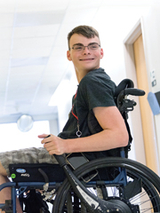
Thirteen-year-old Annie Hamilton worries about school. But it’s not her grades that she’s concerned about. It’s the distance between classrooms.
“She asks me, ‘How can I get to class? Can they move my Chinese class closer to my math class?’” says her father, Tom Hamilton, with heartbreak in his voice.
Annie has Friedreich’s ataxia (FA), a rare genetic disorder that limits the production of frataxin, a protein in the mitochondria, the cells’ energy generators. FA damages the nervous system and impairs muscle coordination, causing problems with movement and sensation that get progressively worse.
For Annie, “walking unassisted is getting difficult,” says Hamilton. “She can’t play tennis anymore. She can’t dance.”
Symptoms almost always begin in childhood. How quickly the disease ravages the body varies. Generally, young adults with FA are confined to wheelchairs; some eventually become completely incapacitated. The biggest danger is developing life-threatening problems in the heart’s musculature. The average age of death is around 40, although some people live for decades longer.
“Many adults with FA just have motor function issues, and they go to college, hold jobs, have families — but others get severe heart disease early,” explains David Lynch, MD, PhD, Director of Children’s Hospital of Philadelphia’s Friedreich’s Ataxia Program and Co-Director of the Friedreich’s Ataxia Center of Excellence. The establishment of the center in 2014 within CHOP and Penn Medicine was catalyzed by a $3.25 million gift from the Hamilton and Finneran families, and in partnership with the Friedreich’s Ataxia Research Alliance (FARA), which helps oversee the funds. Now the families have increased their investment with an additional $3.75 million gift to support the center through 2019.
After Annie was diagnosed with this incurable disease, Hamilton and his wife became despondent — and then determined. “We called FARA. We found CHOP,” says Hamilton. “We asked, ‘What do you guys need? We want to be engaged and help you solve this.’”
Annie’s grandparents Patty and Bill Finneran are supporting FA research to help her — and every person afflicted by FA and related neuromuscular diseases, such as ALS (Lou Gehrig’s disease). “I see what she’s going through,” says Bill Finneran, “and realize there are thousands of others experiencing the same things who will be helped.”

The Ritschel sisters, Angelina, 15, and Samantha, 13, are among the many who could benefit from FA research. They were both diagnosed in 2013. Because Angelina now needs a scooter to get around, “we moved a few months ago into a home with a main-floor bedroom for her,” explains their father, Patrick Ritschel. “Samantha is still ambulatory but is having more difficulty with her balance. FA also impacts what they do socially — it is difficult for them to physically keep up with kids their age, and that is becoming more of a barrier.”
'A big advance'
The multimillion-dollar gifts have allowed CHOP to expand the number of patients Lynch and his team follow; they now care for and collect data from 350 patients. “CHOP alone is seeing about 10 percent of all the people with FA in the U.S.,” says Lynch. “They come back annually for clinical care and research assessment.”

Those patients come from across the country, including Jack DeWitt, 17. FA’s impact on him has been severe. He already requires assistance with all daily tasks, underwent spinal fusion surgery to correct aggressive scoliosis, and has problems with his heart, optic nerves and swallowing function. “Jack travels to CHOP from Michigan every year to better understand his progression, participate in studies and hear about the latest advancements from top FA clinician-researchers,” says his mother, Ruth DeWitt, who describes the CHOP team as “caring, incredibly responsive and absolutely dedicated.”
Data from Jack and all the FA study participants is used to design clinical trials, which lately have yielded very promising results. Lynch points to an experimental drug that improves the body’s ability to make energy, thus partially correcting one of the chemical deficits in people with FA. “In the short term, it has a very impressive effect and is extremely safe,” he says. “This is a big advance.” The study’s next phase will look at the drug’s longer-term effects.
Another study looked at one subtype of FA — instead of not making enough frataxin, these patients make a form that doesn’t work well. A researcher at CHOP found a way to potentially activate the production of more frataxin protein, which Lynch says suggests a new therapy for everyone with the disease.
“Progress comes from people being in the same room talking to each other, which we helped make happen,” says Hamilton. “Every three to four weeks we get about 20 people in a room — researchers, lab techs, the care team, everyone.”
“I believe we’ll discover a cure for this disease,” says Finneran. “I hope we can do it in time for Annie.”
Featured in this article
Specialties & Programs
Thirteen-year-old Annie Hamilton worries about school. But it’s not her grades that she’s concerned about. It’s the distance between classrooms.
“She asks me, ‘How can I get to class? Can they move my Chinese class closer to my math class?’” says her father, Tom Hamilton, with heartbreak in his voice.
Annie has Friedreich’s ataxia (FA), a rare genetic disorder that limits the production of frataxin, a protein in the mitochondria, the cells’ energy generators. FA damages the nervous system and impairs muscle coordination, causing problems with movement and sensation that get progressively worse.
For Annie, “walking unassisted is getting difficult,” says Hamilton. “She can’t play tennis anymore. She can’t dance.”
Symptoms almost always begin in childhood. How quickly the disease ravages the body varies. Generally, young adults with FA are confined to wheelchairs; some eventually become completely incapacitated. The biggest danger is developing life-threatening problems in the heart’s musculature. The average age of death is around 40, although some people live for decades longer.
“Many adults with FA just have motor function issues, and they go to college, hold jobs, have families — but others get severe heart disease early,” explains David Lynch, MD, PhD, Director of Children’s Hospital of Philadelphia’s Friedreich’s Ataxia Program and Co-Director of the Friedreich’s Ataxia Center of Excellence. The establishment of the center in 2014 within CHOP and Penn Medicine was catalyzed by a $3.25 million gift from the Hamilton and Finneran families, and in partnership with the Friedreich’s Ataxia Research Alliance (FARA), which helps oversee the funds. Now the families have increased their investment with an additional $3.75 million gift to support the center through 2019.
After Annie was diagnosed with this incurable disease, Hamilton and his wife became despondent — and then determined. “We called FARA. We found CHOP,” says Hamilton. “We asked, ‘What do you guys need? We want to be engaged and help you solve this.’”
Annie’s grandparents Patty and Bill Finneran are supporting FA research to help her — and every person afflicted by FA and related neuromuscular diseases, such as ALS (Lou Gehrig’s disease). “I see what she’s going through,” says Bill Finneran, “and realize there are thousands of others experiencing the same things who will be helped.”

The Ritschel sisters, Angelina, 15, and Samantha, 13, are among the many who could benefit from FA research. They were both diagnosed in 2013. Because Angelina now needs a scooter to get around, “we moved a few months ago into a home with a main-floor bedroom for her,” explains their father, Patrick Ritschel. “Samantha is still ambulatory but is having more difficulty with her balance. FA also impacts what they do socially — it is difficult for them to physically keep up with kids their age, and that is becoming more of a barrier.”
'A big advance'
The multimillion-dollar gifts have allowed CHOP to expand the number of patients Lynch and his team follow; they now care for and collect data from 350 patients. “CHOP alone is seeing about 10 percent of all the people with FA in the U.S.,” says Lynch. “They come back annually for clinical care and research assessment.”

Those patients come from across the country, including Jack DeWitt, 17. FA’s impact on him has been severe. He already requires assistance with all daily tasks, underwent spinal fusion surgery to correct aggressive scoliosis, and has problems with his heart, optic nerves and swallowing function. “Jack travels to CHOP from Michigan every year to better understand his progression, participate in studies and hear about the latest advancements from top FA clinician-researchers,” says his mother, Ruth DeWitt, who describes the CHOP team as “caring, incredibly responsive and absolutely dedicated.”
Data from Jack and all the FA study participants is used to design clinical trials, which lately have yielded very promising results. Lynch points to an experimental drug that improves the body’s ability to make energy, thus partially correcting one of the chemical deficits in people with FA. “In the short term, it has a very impressive effect and is extremely safe,” he says. “This is a big advance.” The study’s next phase will look at the drug’s longer-term effects.
Another study looked at one subtype of FA — instead of not making enough frataxin, these patients make a form that doesn’t work well. A researcher at CHOP found a way to potentially activate the production of more frataxin protein, which Lynch says suggests a new therapy for everyone with the disease.
“Progress comes from people being in the same room talking to each other, which we helped make happen,” says Hamilton. “Every three to four weeks we get about 20 people in a room — researchers, lab techs, the care team, everyone.”
“I believe we’ll discover a cure for this disease,” says Finneran. “I hope we can do it in time for Annie.”
Contact us
Friedreich's Ataxia Program